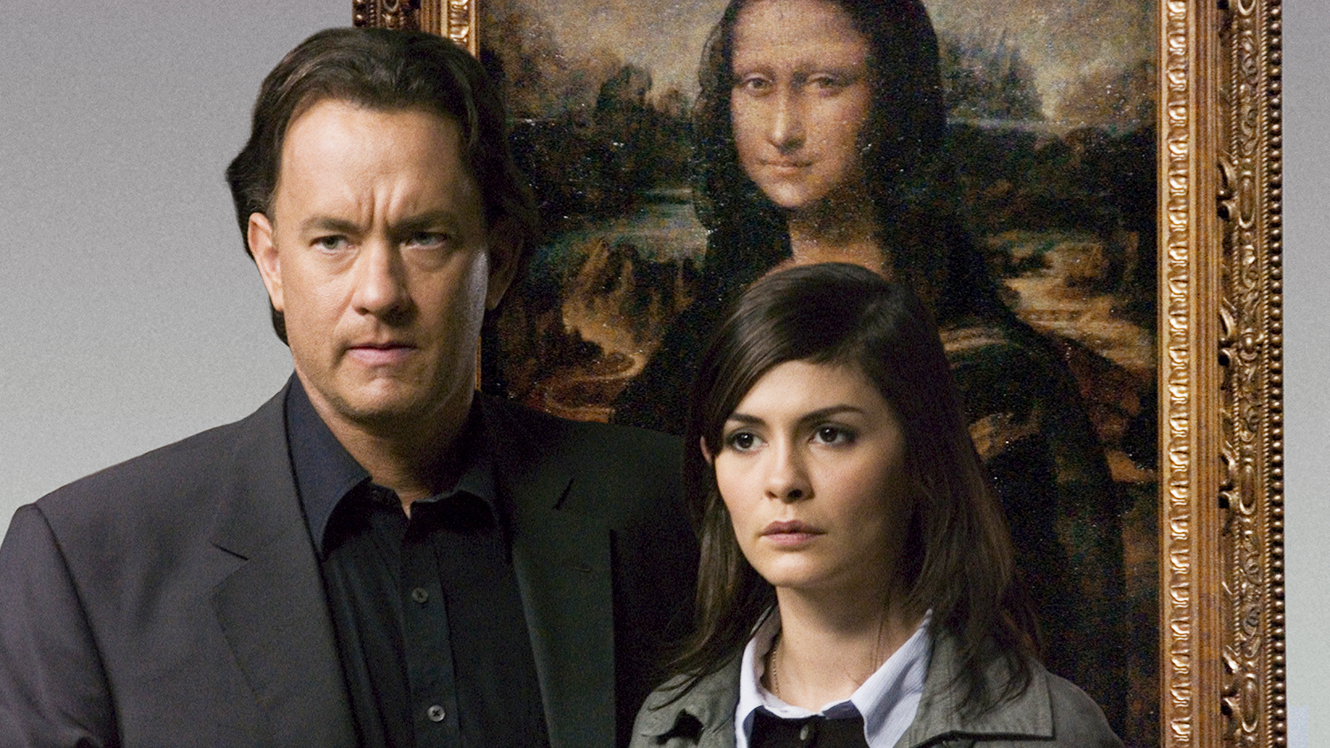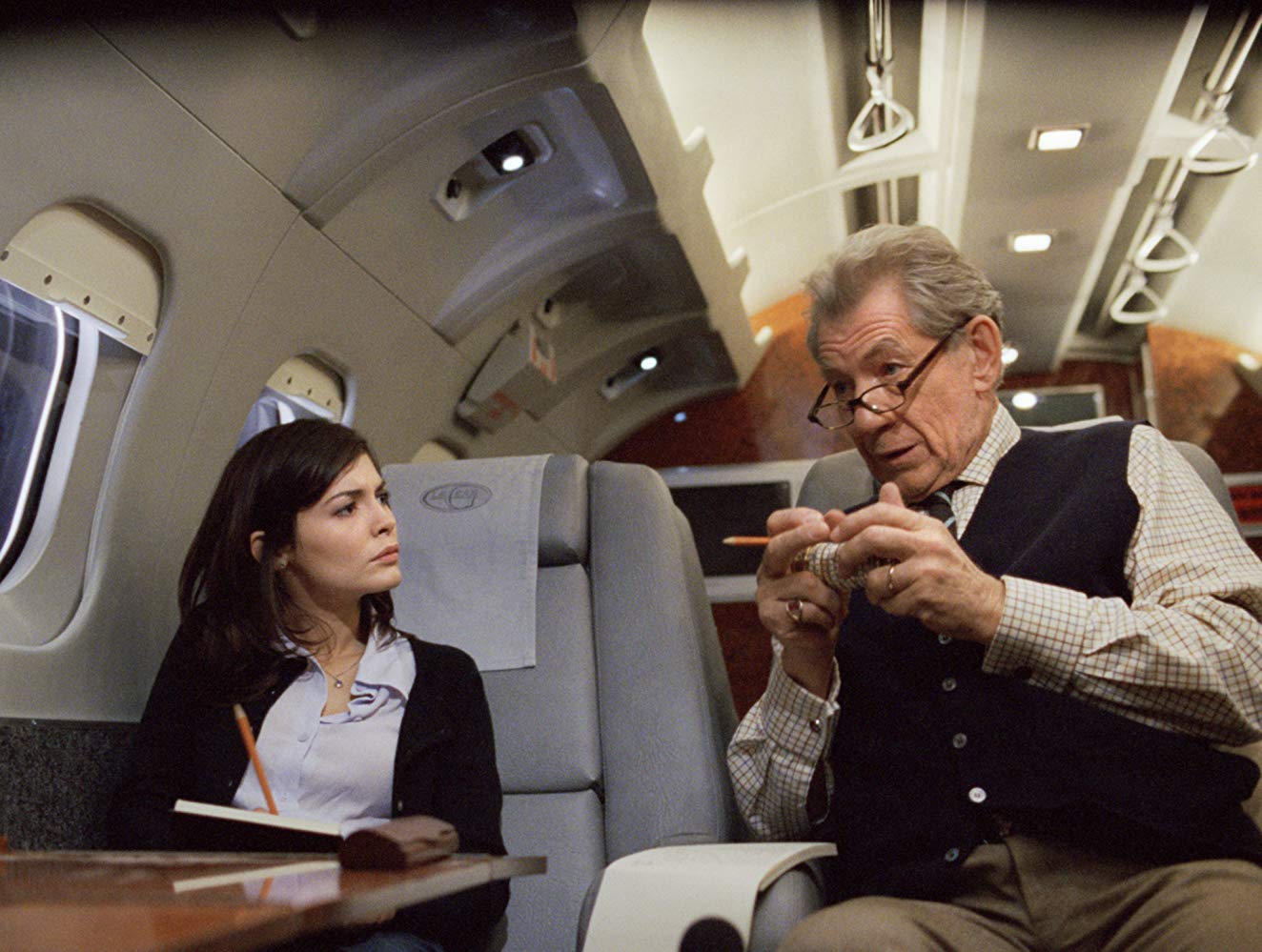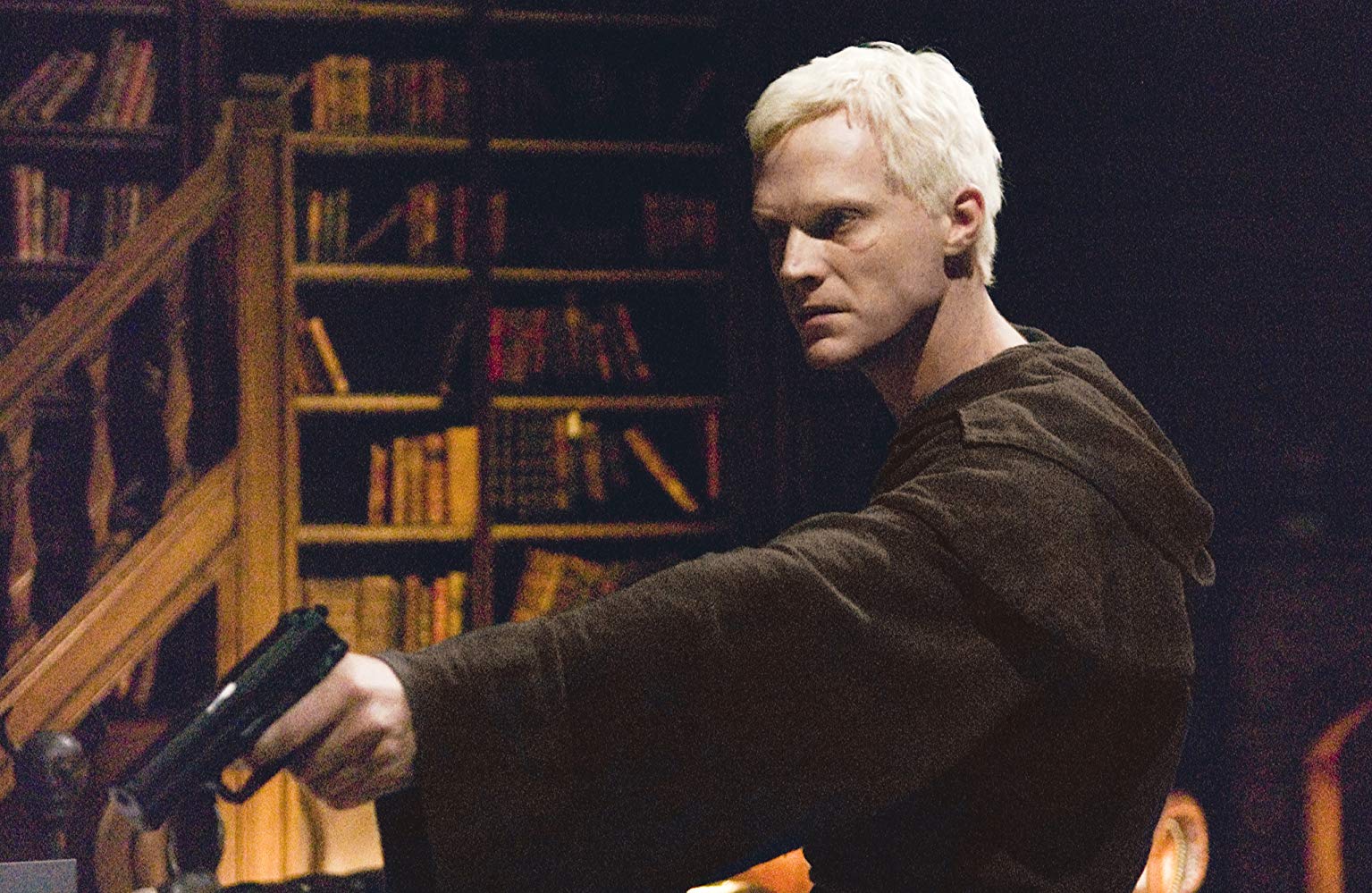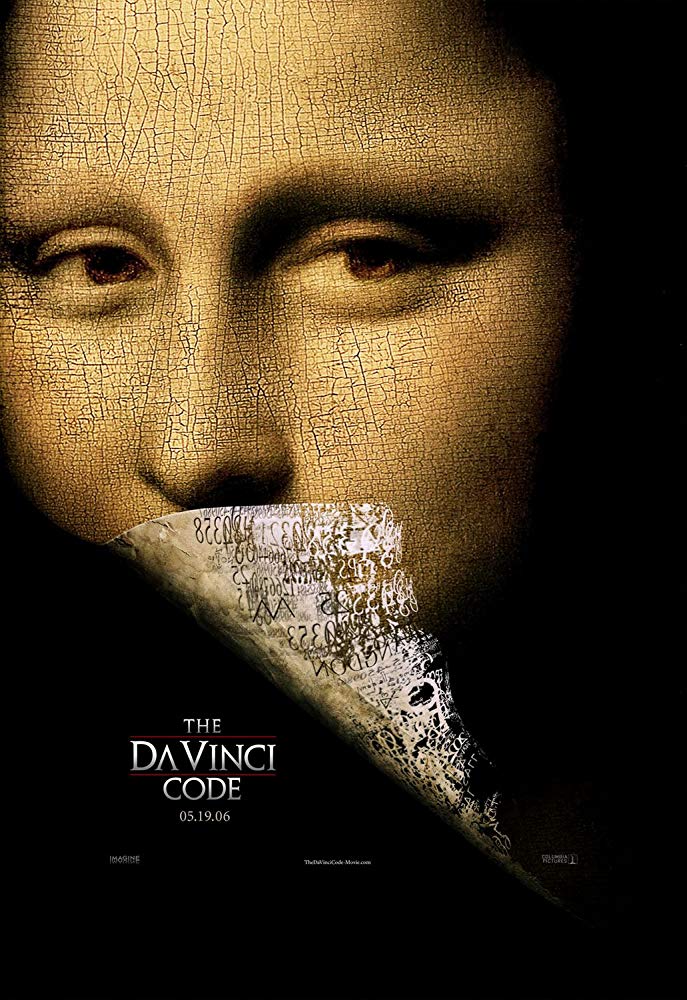USA. 2006.
Crew
Director – Ron Howard, Screenplay – Akiva Goldsman, Based on the Novel by Dan Brown, Producers – John Calley & Brian Grazer, Photography – Salvatore Totino, Music – Hans Zimmer, Visual Effects Supervisor – Angus Bickerton, Visual Effects – Double Negative (Supervisor – Paul Riddle), The Moving Picture Company, Rainmaker Animation and Digital Effects (Supervisor – Mark Breakspear), The Senate Visual Effects Co (Supervisor – James Madigan), Miniatures – Miniatures and Mattes (Supervisor – Leigh Took), Special Effects Supervisors – David Ford & Domini Tuohy, Production Design – Allan Cameron. Production Company – Imagine Entertainment/Skylark Productions.
Cast
Tom Hanks (Professor Robert Langdon), Audrey Tautou (Sophie Neveu), Ian McKellen (Sir Leigh Teabing), Jean Reno (Captain Bezu Fache), Paul Bettany (Silas), Alfred Molina (Bishop Aringarosa), Jurgen Prochnow (Andre Vernet), Etienne Chicot (Lieutenant Collet), Jean-Yves Berteloot (Remy Jean), Jean-Pierre Marielle (Professor Jacques Sauniere), Marie-Francoise Audollent (Sister Sandrine)
Plot
Robert Langdon, a Harvard professor of symbology, is on a lecture and book-signing tour in Paris when he is approached by the Surete, who ask his help in solving a murder at The Louvre. The victim is Jacques Sauniere, a colleague that Langdon had an appointment to meet. Before he died, Sauniere managed to write a series of cryptic phrases and symbols at the murder scene. Langdon is aided in interpreting these by the police’s cryptology specialist Sophie Neveu, Sauniere’s granddaughter. She tells Langdon that he is in great danger and helps him to escape. They begin to trace the clues that Sauniere left, which lead to artworks in The Louvre and local churches. At the same time, the police regard Langdon and Sophie as the prime suspects in the murder and they are determinedly pursued by police captain Bezu Fache. Fache is also a member of the secretive Catholic order Opus Dei. Opus Dei is determined to quash the information that Sauniere knew and has sent an assassin to eliminate all those linked to the case. Langdon realizes that they are dealing with the Priory of Sion, an ancient order that included names like Sir Isaac Newton and Leonardo Da Vinci among its numbers, and stretches back to the time of Christ. Hunted, they seek refuge with Priory expert Sir Leigh Teabing who tells them the secret that the Priory guards – that Jesus Christ did not die but took Mary Magdalene as his wife and sired a bloodline with her that has present day descendants. This is a secret that the Catholic Church desperately wants to eradicate in order to protect their dogma. Langdon, Sophie and Teabing now engage in a race against the French authorities and Opus Dei to find the location of Mary Magdalene’s tomb, which would conclusively prove the existence of the bloodline.
Dan Brown’s novel The Da Vinci Code (2003) has become an extraordinary phenomenon that took over the entire world, selling some 60 million copies. There were an amazing number of spinoffs – illustrated versions of the novel, illustrated coffee table guidebooks to the locations and artworks, a special movie tie-in version of the novel, books by other authors exploring the legend of the Priory of Sion and Sauniere bloodline. I have counted some 18 separate books either debunking or analyzing the Da Vinci Code, as well as a good many parodies. There have even been tv documentaries that go into the subject, as well as a Da Vinci Code computer game and at least three different board games, all sanctioned by Dan Brown. One can even take Da Vinci Code tours of the European sites mentioned in the book. And then there was this film adaptation.
It may well be that future analysts of pop culture of the 2000s will look back on Da Vinci Code madness with something akin to the way we look back on the fad for Ancient Astronauts that we had in the 1970s following the publication of Eric von Daniken’s Chariots of the Gods (1968). There von Daniken liberally interpreted artifacts from antiquity as proof that he claimed demonstrated that aliens had visited the ancient world and influenced the course of human development. Von Daniken’s nonsense inspired a fad and numerous imitators built upon his thesis. There is a good deal of similarity between von Daniken and Dan Brown – both offer up radical interpretations of history; both twist history out of shape and give it cryptic symbolic meaning to argue their case; both have been derided for their inaccuracies by historians; and both have created an enormous fad that has verged on a religious following. (If nothing else, one can celebrate The Da Vinci Code for having made history, architecture and classic art something sexy with the general public again).
Dan Brown is teacher from New Hampshire who, up until the mass success of The Da Vinci Code, had pursued an unsuccessful career as a songwriter. Brown had written three earlier novels – Digital Fortress (1998), Angels and Demons (2000) and Deception Point (2001) – that had enjoyed only middling success (but became bestsellers upon subsequent reprinting). Most of Dan Brown’s books centre around a fascination with cryptology and puzzles (as a child, Brown’s father would create treasure hunts using cryptic trails of clues for he and his siblings on birthdays and Christmas) and secret societies.

Though a British court cleared Dan Brown of plagiarism charges just before the film opened, the bulk of The Da Vinci Code was taken from an earlier non-fiction book The Holy Blood and the Holy Grail (1982) by authors Michael Baigent, Richard Leigh and Henry Lincoln. Baigent et al laid down the notion that Jesus Christ married Mary Magdalene, that they founded the Merovingian Dynasty and that Christ’s descendants live in present-day France, that this union is the real meaning of the mythic Holy Grail, that the secret has been kept throughout the ages by the Priory of Sion, and that the Catholic Church has attempted to stamp out the truth and protect the notion that Christ is divine. Whatever the outcome of the case, Dan Brown has undoubtedly borrowed the thesis from The Holy Blood and the Holy Grail – he even signalled his plagiarism by naming the book’s central Grail scholar (played by Ian McKellen in the film) Leigh Teabing by borrowing two of the names of the authors (Teabing being an anagram of Baigent). Not that their outrage at having their idea stolen stopped Baigent, Leigh and Lincoln from reissuing The Holy Blood and the Holy Grail and Michael Baigent’s follow-up The Jesus Papers (2006) as “the book(s) that inspired The Da Vinci Code“.
Baigent, Leigh and Lincoln’s work came under considerable historical ridicule. This went into overkill following the The Da Vinci Code. Among other things, experts have derided Dan Brown’s claim in his foreword that The Da Vinci Code is completely accurate in its depiction of artworks and historical detail. Most art scholars agree that it is not Mary Magdalene depicted in Leonardo Da Vinci’s The Last Supper – like the small fact that Leonardo only has twelve figures in the painting, meaning that one of the disciples would have to be absent for it to be Mary who was present. There are numerous other details – that there is no chair in any such a field as symbology at Harvard (nor any other university); that Brown wildly overstates the Emperor Constantine’s involvement in the formation of the canonical Gospels; and that most of the claims concerning The Knights Templar have been bent out of shape. The real Church of Saint-Sulpice has been forced to issue denials to tourists that it is on any Paris meridian or Rose-line. Most importantly, it has been conclusively shown that the idea of the Priory of Sion was fabricated by French monarchist and anti-Semite Pierre Plantard in the 1950s, wherein Plantard created hoax documents in order to claim that he himself was a descendant of the Merovingian line. No wacky idea seems too far out for Dan Brown to include. Like Erich von Daniken, Brown sees symbolism to fit his case in everything – everything that has a V or curved shape, from the blank space in The Last Supper to the arches of Gothic cathedrals is clearly a symbol of the womb, thus is evidence of a suppressed fertility cult.
You also wonder, if Christ was divine rather than merely a man – why would he set up something like a bloodline? The whole point of Christianity is that Jesus Christ is a symbol – of sacrifice, that he died for the whole world’s sins etc etc – and that if he is that, which Brown and the film seems to sit on the fence as to whether he was or not, why should he concern himself with a lineage? What Brown does not seem to see is that the notion of a lineage, the belief that power is carried by the head of a family, is a modern Royalist one. (This also waters the concept down – this supposed lineage requires each of the descendants over the last 2000 years to have improbably had only one child, because the more they have the more the bloodline is diluted and spread around, meaning that there could be thousands of families with Christ heritage in their veins). Although the bottom argument for any idea against a secret history of Christianity is this – there is no independent evidence outside of The Gospels that Jesus Christ ever existed. (References in the contemporary Jewish scholar Josephus is widely believed by historians to have later been fictitiously added by Christians). And so to claim a secret history of The Gospels is surely a double hypothetical leap in that it purports to interpret secret meanings of a religious text that nobody has conclusively proven to be factual in the first place.

The surprise about such nonsense, which under most serious examinations simply reveals itself as entertaining hokum but bad history and worse theology, is that people take it seriously. The worldwide opening of the film was greeted with protests from the Catholic Church, most notably Opus Dei who are understandably peeved at being portrayed as the villains of the show. (Although considering Opus Dei’s often cult-like activities and fascist leanings of its founder, this plea of blamelessness is a little hard to swallow). There were riots in India and the film was banned in Pakistan, Sri Lanka and Samoa and released in censored form in some Christian countries. There were protests from NOAH (The National Organization for Albinism and Hypopigmentation) concerning the portrayal of albinos in the film, even from unlikely places such as some Islamic countries and with the film surprisingly being banned by the atheist China.
The film adaptation of The Da Vinci Code has ended up in the hands of director, former actor Ron Howard. Ron Howard has a directing career that began back in the 1970s and has become most known for films like Cocoon (1985), Far and Away (1992), The Paper (1994), Apollo 13 (1995), A Beautiful Mind (2001), Cinderella Man (2005) and Frost/Nixon (2008). (A list of Ron Howard’s other genre contributions are at the bottom of the page). Howard is someone who has gone from a youthful actor – The Andy Griffith Show (1960-80), Happy Days (1974-84) – to a director of comedies – Night Shift (1982), Splash! (1984) – to films that have become increasingly more mainstream and bogged down by what at times feels like a painfully earnest effort on Howard’s part to be regarded as a “Serious” filmmaker. Regrettably, Ron Howard’s work has a constant blandness. While he seems driven by a desire to make serious messages and be a dramatist, this is something that Howard seems unable to deliver in anything other than feelgood clichés.
The Da Vinci Code novel made for a page-turning read. There were even calls for Dan Brown with his stilted and one-dimensional prose to be regarded as ‘a great author’. Alas the same cannot be said for the film. In Ron Howard’s hands, Dan Brown’s page-turner of a novel has become a plodding film that does little more than serve as an illustrated guide for those who have already read the book. Ron Howard, though he does a reasonable job of illustrating Dan Brown’s historical thesis, never gets inside the cryptographic games that Brown played – all we see are words being illuminated and moving around the screen, but not the logical deductions that Tom Hanks makes.

In Ron Howard’s hands, some of Dan Brown’s plot devices emerge as absurdly far-fetched – a bunch of academics manage to evade most of the police force of Europe and become stunt drivers; somewhat unbelievably no security alarms are triggered when Tom Hanks and Audrey Tautou approach and touch various artworks in The Louvre; the breakout from the armoured truck by putting a shell case in the door jamb is singularly unconvincing; and the scene where the police somehow manage to neglect to search Teabing’s Rolls after his plane lands in England defies credulity (not to mention the fact that the plane lands and smuggles fugitives from the law into the country without ever seeming to have to go through a customs check). Most particularly far-fetched of all is the clunkily obvious revelation of the identity of The Teacher.
The roles in the film are one-dimensional (although here at least the film is being accurate to the book). The parts played by Audrey Tautou, Jean Reno and Alfred Molina could all have been played by anyone. Even Tom Hanks has what must be the most anonymous role he has ever played, where he fails to distinguish the part in any way. The only one who stands out is Ian McKellen who plays the whole nonsensical farrago with an impish sense of mischief.
Ron Howard and Tom Hanks reteamed for two sequels with Angels & Demons (2009), based on one of Dan Brown’s earlier works, which has been reworked as a sequel and features Langdon solving another cryptic puzzle concerning a murder mystery in The Vatican, and Inferno (2016) with Langdon racing around European artworks in search of a deadly virus that can wipe out 95% of the world population. Ron Howard subsequently produced an adaptation of Dan Brown’s third Langdon novel as the tv mini-series The Lost Symbol (2021) starring Ashley Zukerman as a young Langdon.
The Da Vinci Code was parodied in Epic Movie (2007) and the Futurama episode The Duh-Vinci Code (2010), while being blatantly copied in The Asylum’s The Da Vinci Treasure (2006). There was also a spate of documentaries that deal with the so-called facts in Dan Brown’s book with Cracking the Da Vinci Code (2004), Da Vinci Decoded (2004), Breaking the Da Vinci Code (2005), The Real Da Vinci Code (2005) and Time Machine: Beyond the Da Vinci Code (2005).
Ron Howard’s other films of genre interest are:– Cocoon (1985) about a meeting between geriatrics and extra-terrestrials; the George Lucas sword-and-sorcery collaboration Willow (1988); Apollo 13 (1995) based on the true life 1970 space mission disaster; the Dr Seuss adaptation How the Grinch Stole Christmas (2000); the supernatural Western The Missing (2003); and Solo: A Star Wars Story (2018).
Screenwriter Akiva Goldsman has also written the scripts for the Joel Schumacher Batman films Batman Forever (1995) and Batman & Robin (1997), the big-screen remake of tv’s Lost in Space (1998), the witchcraft comedy Practical Magic (1998), the Oscar-winning A Beautiful Mind (2001), I, Robot (2004), I Am Legend (2007), Insurgent (2015), The 5th Wave (2016), The Dark Tower (2017), Rings (2017) and Transformers: The Last Knight (2017). He made his directorial debut with the fantasy Winter’s Tale (2014), followed by the horror film Stephanie (2017). Goldsman has also produced Renny Harlin’s two genre outings the monster movie Deep Blue Sea (1999) and the serial killer thriller Mindhunters (2004), as well as the comic-book adaptation Constantine (2005), the paranormal investigators tv series Fringe (2008-13), the superhero film Hancock (2008), the supernatural Western comic-book adaptation Jonah Hex (2010), Paranormal Activity 2 (2010), Paranormal Activity 3 (2011), Paranormal Activity 4 (2012), the tv mini-series adaptation of Arthur C. Clarke’s Childhood’s End (2015), Guy Ritchie’s King Arthur: Legend of the Sword (2017), Doctor Sleep (2019), The Map of Tiny Perfect Things (2021), Firestarter, Meet Cute (2022) and the tv series’ Star Trek: Discovery (2017-24), Titans (2018-23), Star Trek: Picard (2020-3) and Star Trek: Strange New Worlds (2022- )..
Trailer here


